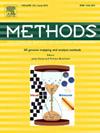确定肝细胞癌中五个关键区域的四个关键组蛋白修饰共同调控的靶基因。
IF 4.2
3区 生物学
Q1 BIOCHEMICAL RESEARCH METHODS
引用次数: 0
摘要
肝细胞癌(HCC)是一种发病率和死亡率都很高的癌症。研究表明,组蛋白修饰在 HCC 的发生和发展中起着重要的调控作用。然而,组蛋白修饰对 HCC 基因表达的具体调控作用仍不清楚。本研究以 HepG2 细胞系和肝细胞系为研究对象。首先,计算并分析组蛋白修饰信号在两种细胞系中的分布。然后,利用随机森林算法分析了不同组蛋白修饰及其修饰区域对两种细胞系基因表达的影响,得到了四种关键组蛋白修饰(H3K36me3、H3K4me3、H3K79me2和H3K9ac)和五个共同调控基因表达的关键区域。随后,筛选出受关键区域中关键组蛋白修饰调控的靶基因。结合临床数据,对靶基因进行了Cox回归分析和Kaplan-Meier生存分析,确定了与预后相关的四个关键靶基因(CBX2、CEBPZOS、LDHA和UMPS)。最后,通过对关键靶基因的免疫浸润分析和药物敏感性分析,证实了关键靶基因在 HCC 中的潜在作用。我们的研究结果为探讨HCC的发生提供了理论依据,并提出了与组蛋白修饰相关的潜在生物标志物,这些生物标志物可能成为临床治疗HCC的潜在药物靶点。本文章由计算机程序翻译,如有差异,请以英文原文为准。
Identification of target genes co-regulated by four key histone modifications of five key regions in hepatocellular carcinoma
Hepatocellular carcinoma (HCC) is a cancer with high morbidity and mortality. Studies have shown that histone modification plays an important regulatory role in the occurrence and development of HCC. However, the specific regulatory effects of histone modifications on gene expression in HCC are still unclear. This study focuses on HepG2 cell lines and hepatocyte cell lines. First, the distribution of histone modification signals in the two cell lines was calculated and analyzed. Then, using the random forest algorithm, we analyzed the effects of different histone modifications and their modified regions on gene expression in the two cell lines, four key histone modifications (H3K36me3, H3K4me3, H3K79me2, and H3K9ac) and five key regions that co-regulate gene expression were obtained. Subsequently, target genes regulated by key histone modifications in key regions were screened. Combined with clinical data, Cox regression analysis and Kaplan-Meier survival analysis were performed on the target genes, and four key target genes (CBX2, CEBPZOS, LDHA, and UMPS) related to prognosis were identified. Finally, through immune infiltration analysis and drug sensitivity analysis of key target genes, the potential role of key target genes in HCC was confirmed. Our results provide a theoretical basis for exploring the occurrence of HCC and propose potential biomarkers associated with histone modifications, which may be potential drug targets for the clinical treatment of HCC.
求助全文
通过发布文献求助,成功后即可免费获取论文全文。
去求助
来源期刊

Methods
生物-生化研究方法
CiteScore
9.80
自引率
2.10%
发文量
222
审稿时长
11.3 weeks
期刊介绍:
Methods focuses on rapidly developing techniques in the experimental biological and medical sciences.
Each topical issue, organized by a guest editor who is an expert in the area covered, consists solely of invited quality articles by specialist authors, many of them reviews. Issues are devoted to specific technical approaches with emphasis on clear detailed descriptions of protocols that allow them to be reproduced easily. The background information provided enables researchers to understand the principles underlying the methods; other helpful sections include comparisons of alternative methods giving the advantages and disadvantages of particular methods, guidance on avoiding potential pitfalls, and suggestions for troubleshooting.
 求助内容:
求助内容: 应助结果提醒方式:
应助结果提醒方式:


